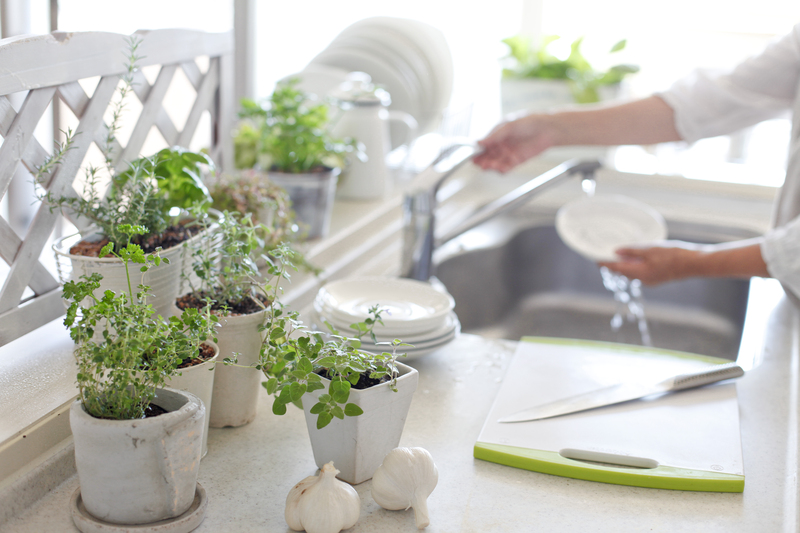Transforming a Neglected Garden into a Lush Paradise
Posted on 12/06/2025
Dreaming of a beautiful, thriving garden but facing a weed-filled and forgotten backyard? Too often, precious outdoor spaces fall into neglect, quickly sprouting overgrown grass, invasive weeds, and wayward shrubs. Yet, with the right strategy and a bit of effort, you can turn any neglected garden into a lush paradise--overflowing with color, fragrance, and life. This comprehensive guide will walk you through everything you need to know about restoring, designing, and maintaining a once-abandoned garden, providing practical tips and inspiration every step of the way.
Assessing Your Neglected Outdoor Space
Before embarking on your garden transformation, it's crucial to thoroughly assess the current state of your overgrown plot. Understanding the scale of the challenge will help you plan efficiently and set realistic goals for your garden's rebirth.
Step 1: Survey the Scene
- Take inventory: Walk through your garden, making notes or sketches of what you observe. Identify problem areas such as stubborn weeds, bare patches, fallen branches, or crumbling pathways.
- Check existing plants: Some 'weeds' might be wildflowers or valuable perennials. Identify and tag plants you want to keep as the foundation of your new vision.
- Test the soil: Use a simple soil testing kit to check pH and drainage. This information will help you select plant varieties that will flourish in your garden's unique environment.
- Observe sunlight: Watch how sunlight moves across the space during the day. Not all areas receive the same light, so noting sun and shade spots is key for effective planting.
Why Assessment Matters
Skipping this initial step leads to costly mistakes and wasted time. By thoroughly evaluating your neglected backyard, you prepare a solid foundation for a garden transformation that lasts for years to come.

Planning Your Lush Garden Makeover
{@Transforming a neglected garden@} is both an art and a science. Thoughtful planning ensures harmonious design, optimal plant selection, and a smooth renovation process. Here are the essential steps for reimagining your outdoor oasis:
Step 2: Establish a Vision and Theme
- Visualize your dream space: Do you picture a serene Zen sanctuary, vibrant cottage garden, or productive vegetable patch? Gather images and inspirations that reflect your ideal garden style.
- Consider function: Will your garden only be for quiet relaxation, or do you need areas for play, dining, or entertaining guests?
- Set priorities: Decide which changes are essential and which can wait. This helps spread costs and effort over time.
Step 3: Create a Master Plan
Draw up a rough sketch or blueprint of your garden, labeling:
- Existing features you want to retain (e.g., mature trees or seating areas)
- Spaces for new flower beds, lawn restoration, or vegetable plots
- Paths, patios, or water features
- Sun and shade zones for appropriate plant placement
Tip: Use garden planning apps or graph paper to scale your design, helping visualize proportions and spacing more accurately.
Clearing and Rejuvenating the Garden
With your plan in place, it's time to tackle the basic garden cleanup. This can be the most physically demanding phase but also the most rewarding as you begin revealing your garden's underlying beauty.
Step 4: Remove Debris and Weeds
- Rake and clear debris: Remove fallen leaves, branches, garbage, and anything else obscuring the soil.
- Pull weeds: For best results, remove entire root systems to prevent regrowth. Use sturdy gloves and tools like weed pullers or hoes.
- Dispose responsibly: Compost organic matter, recycle what you can, and safely dispose of plastics or hazardous materials.
Step 5: Prune, Trim, and Rejuvenate
- Prune shrubs and trees: Remove dead, diseased, or crossing branches to promote healthy new growth.
- Cut back perennials: Trim overgrown plants to ground level. Most will bounce back with vigor in spring.
- Tame lawns: If grass is wildly overgrown, use a strimmer or scythe to reduce height before mowing.
Step 6: Restore Hardscaping
- Repair paths and patios: Level uneven pavers, reset bricks, or patch up cracked concrete.
- Refresh fences and trellises: Paint or stain weathered timber and repair gaps or loose panels.
- Inspect garden structures: Check sheds, arbors, and benches for repairs or upgrades.
After clean-up, your garden will feel fresh and ready for the next exciting phase--planting and design!
Soil Improvement for a Flourishing Garden
Healthy soil is the backbone of a verdant, thriving paradise. During your garden revival, dedicate time and resources to soil enrichment.
Step 7: Amend and Nourish
- Loosen compacted soil: Use a garden fork or tiller to aerate soil and allow oxygen, nutrients, and water to penetrate.
- Incorporate organic matter: Add compost, well-rotted manure, or leaf mold to boost fertility and structure.
- Balance soil pH: If your test revealed acidic or alkaline soil, add lime or sulfur as required.
- Mulch generously: Layer bark, straw, or leaf mulch to suppress weeds, retain moisture, and gradually improve the soil as it breaks down.
Benefits of Soil Restoration
Rich, well-aerated earth encourages strong root growth, robust blooms, and healthier plants, laying the groundwork for your lush paradise.
Selecting Plants for Your Rejuvenated Garden
Plant choice is central to transforming a tired yard into a verdant haven. For sustainability and beauty, choose varieties that suit your climate, light conditions, and maintenance preferences.
Step 8: Choose the Right Plants
- Native species: These require less water, are more resistant to local pests, and support biodiversity.
- Layered planting: Combine trees, shrubs, perennials, annuals, and groundcovers for a lush, multi-dimensional look.
- Evergreens: Include evergreens for structure and year-round interest.
- Pollinator-friendly flowers: Attract butterflies, bees, and birds with lavender, echinacea, buddleia, and herbs.
- Drought-tolerant plants: If water is scarce, opt for sedum, lavender, or ornamental grasses.
- Edibles: Herbs, vegetables, and fruit bushes add productivity to your lush garden paradise.
Tip: Visit local nurseries and seek expert advice on best choices for your region and microclimate.
Designing Beauty: Paths, Features, and Water Elements
Beyond plants, consider adding structure and charm to your renewed garden. Garden landscaping involves blending hardscaping and focal points for elegance and function.
Step 9: Pathways and Patios
- Natural stone paths: Weave attractive pathways through plantings for exploration and access.
- Gravel or bark trails: Affordable and low-maintenance, ideal for informal gardens.
- Patio nooks: Create seating areas with paving, pebbles, or wooden decking for relaxation.
Step 10: Water and Wildlife Features
- Pond or birdbath: Invite birds, frogs, and dragonflies while adding tranquility.
- Waterfall or fountain: The sound of running water brings peace and masks city noises.
- Wildlife hotels: Log piles, bug hotels, and birdhouses foster a thriving ecosystem.
Maintaining Your New Garden Paradise
The secret to enduring garden beauty isn't just hard work at the beginning, but consistent care throughout the seasons. Establish easy routines and smart practices to keep your revamped garden at its best.
Step 11: Regular Care and Seasonal Tasks
- Water as needed: Focus on new plantings and hot, dry periods. Drip irrigation or soaker hoses save time and water.
- Feed and fertilize: Use organic fertilizers in spring and late summer to fuel growth.
- Deadhead and prune: Removal of spent blooms encourages repeat flowering, while pruning maintains shape and vigor.
- Mulch annually: Reapply mulch each spring or fall to keep weeds at bay and enrich soil.
- Monitor pests: Encourage beneficial insects and remove pests by hand when possible, minimizing chemical use.

Creative Finishing Touches
With cleanup, planting, and pathways complete, infuse extra magic with personal touches:
- Garden art: Sculptures, mosaics, or upcycled furniture add whimsy and character.
- Lighting: Install solar or fairy lights to highlight key areas and extend enjoyment into evenings.
- Outdoor living: Add benches, swings, hammocks, or outdoor dining setups for year-round use.
- Container displays: Pot up colorful annuals or herbs for instant impact on patios and doorways.
Transform Your Neglected Garden into a Paradise Today
Revitalizing a neglected backyard doesn't happen overnight, but each step brings you closer to the lush escape you deserve. Start with a clear vision, break the project into manageable phases, and enjoy the satisfaction of seeing barren spaces bloom with life. Whether you aim for a vibrant flower garden, serene retreat, or productive edible oasis, the results will reward you every day.
Ready to begin your transformation? Gather your tools, rally family or friends, and take that first step. The paradise awaiting you is well worth the effort!
Frequently Asked Questions About Garden Revitalization
- How long does it take to transform a neglected garden?
Depending on the size and level of neglect, a basic transformation can take from a few weekends to several months. Phased approaches help spread effort and maintain motivation. - What are the most important first steps?
Assessment, basic cleanup, soil improvement, and planning are essential for lasting success. - Can I restore my garden on a budget?
Yes! Reuse existing plants, shop for bargains at plant sales, and use recycled materials for landscaping to keep costs low.
For more tips on transforming neglected gardens, subscribe to our newsletter or explore our library of gardening guides. Unlock the limitless potential of your outdoor space, and soon you'll be enjoying your very own lush paradise!



